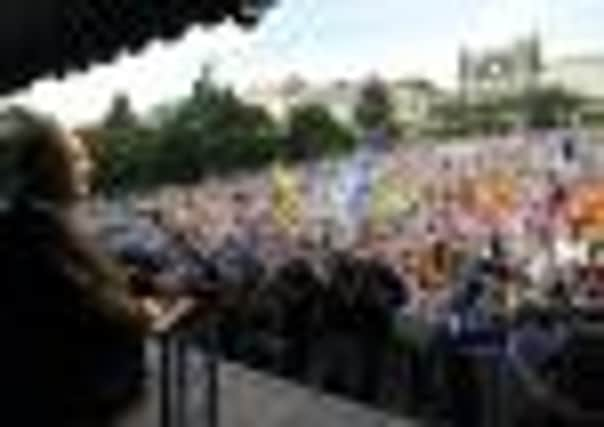Leaders: Voice for change | On the right track


It is useful to remind ourselves at times that unlike nationalist groupings in some other parts of the world – which can be culturally intolerant and exclusive – Scotland is fortunate to have a nationalist movement that goes out of its way to be inclusive and to celebrate diversity. This civic nationalism is one of the great achievements of the modern SNP, and our political discourse in this small nation is all the more healthy for it.
But, as we look forward to the referendum in 2014, what did yesterday’s event say about the state of the Yes campaign at this point in time? The answer is that it inadvertently revealed some tensions within the pro-independence movement that could prove troublesome in the coming months. Yesterday’s march and rally was put together by Jeff Duncan, who was instrumental in the Save The Scottish Regiments campaign. It was organised on a shoestring, without the administrative support and public relations clout available to the official Yes campaign and the SNP itself. The Yes campaign provided it with some publicity. But the SNP was decidedly cool towards it. For a political party so savvy in its use of the internet it was a little bizarre that there was not one mention of the rally on the SNP’s website and, until the rally was actually underway, no mention of it on the party’s feed on the social networking site Twitter. Given that the march and rally was in support of the SNP’s big idea – a free Scotland – this looks less like a simple oversight and more like a deliberate snub. The result was a rally which – attracting 5,000 people by the police’s estimate – was a massive under-representation of the strength and commitment of the pro-independence movement in this country.
Advertisement
Hide AdAdvertisement
Hide AdLooking at it from the outside, this might seem curious. Why on earth wouldn’t the SNP lend this event its full support, and make it a much bigger success (even if common sense suggests it came far too early in the campaign)? In fact, it provides a useful clue to an emerging truth about the referendum. The reality is that the SNP approach to this campaign is very different in tone and tenor to the one being adopted by the more broadly-based Yes campaign (which presents itself as an umbrella group, albeit with the SNP as one of its key components) and other informal groupings such as the one that organised yesterday’s rally. The latter want to project independence as an opportunity for Scotland to let a thousand flowers bloom, as a transformative moment of momentous change and possibility. The SNP strategy, in as far as it can be discerned at the moment, seeks to do the opposite, presenting independence as simply a step forward for home rule, with no change to many of the definitively British aspects to how we are governed (with the monarchy, currency and macroeconomic policy remaining the same, and Scotland staying in Nato and the European Union).
As we go forward, the voters will be hearing two different – and contradictory – messages about what a Yes vote will mean. Doubtless, when the anti-independence campaign gathers pace it too will offer a range of tensions and contradictions. But at the moment the Yes campaign, lagging in the polls, is the one that needs the momentum, and confusion about the message will not help.
On the right track
FIGURES showing that rail travel is booming in Scotland are heartening and show that the public will let the train take the strain if reliable services are provided. The reopening of the £300 million Airdrie-Bathgate line in 2010 heads the list of recent success stories which
are luring drivers out of their cars and into rail carriages with all the benefits that brings in terms of less congested roads
and a healthier environment. Fares being set at reasonable prices have also played their part in a rise in ScotRail
passenger traffic of more than a third – to 81 million
journeys – since 2004. But it cannot be right that the best value fares between some of our biggest communities are not
being brought to the attention of hard-pressed travellers. Rail operators should be compelled to flag up their cheapest tariffs between destinations so that passengers who inadvertently pay over the odds do not feel cheated at journey’s end. There will be no more certain way of persuading their customers to return to behind the wheel. Sorting out the anomalies that remain – some of them dating back to the days of British Rail – should be a priority for the Scottish Government’s transport minister Keith Brown. He may not be able to make all the trains run on time but he can make sure that rail travel becomes even more attractive.